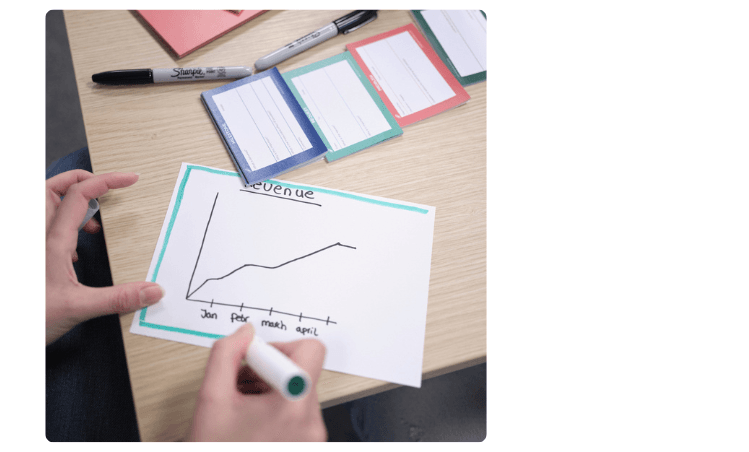Accelerating the growth of a start-up
Case Levvr: How do you keep a fast-growing start-up on track as complexity increases and the need for clear communication and efficiency continues to rise?

The challenge
The start-up Levvr is developing a project management hub that helps parties in the construction industry strike the right balance between quality, costs, and scheduling. Over the past few years, it has grown rapidly and is currently focused on further developing its software platform. This enables clients such as Heijmans, the Municipality of Amsterdam, and Dutch Boosting Group to embrace a “knowledge-driven” approach, working smarter with each project.

Levvr is looking ahead and asking itself:
“What do we, as a leadership team and organization, need to continue growing healthily, and if possible, accelerate this growth further?”
Obeya Coaching & Training was invited to collaborate, and Bertus Groenewegen took on the challenge.

Bertus: “When I started, I saw a driven leadership team that was aware of the main growth bottlenecks. They had outlined all the necessary elements for the company to grow: from strategic documents to an overview of operations, but there was a lack of cohesion and visualization to connect strategy with execution.
Additionally, there were many informal updates and scattered meetings, a habit from when the team was smaller. This was a clear signal to me that an improved rhythm and tighter routine could benefit the larger team. There was much to gain here.”

Approach: The Obeya Team Kickstart
How do you accelerate a start-up in full growth? “We identified the main growth barriers,” says Bertus. The leadership team highlighted the following challenges, which were addressed using visualization and Leading with Obeya:
- Difficulty in fully mapping the ‘state of the business.’
- Insufficient insight into the progress of initiatives, leading to irregular check-ins, confusion, and lost time.
- Difficulty translating vision and mission into strategy and operational initiatives.
- Limited data-driven decision-making.

During the Obeya Team Kickstart
Together with the leadership team, we translated and logically organized the existing strategic documents visually according to the Leading with Obeya method on the Strategic Direction boards.
The first step was to define the necessary strategic capabilities, after which we could determine the performance indicators to achieve the company’s ambitions. During this interactive session, it became clear that not all existing indicators aligned with the strategic capabilities, leading to valuable discussions and refined indicators. This was the result of day 1 of the kickstart.

As the Obeya was filled with all relevant strategic and control information, the leadership team could immediately gain experience with the bi-weekly Performance meetings. We collectively reviewed existing meetings and consolidated them into the Rhythm and Routine according to the Leading with Obeya method.
The Act and Respond session, similar to a daily stand-up held three times a week, significantly reduced the number of meetings, emails, and individual phone calls. Issues and requests were placed in an inbox beforehand, ensuring the sessions ran efficiently and structured. This resulted in more effective communication and a significant reduction in digital traffic and time loss.

Results
According to Tom van de Vrede, co-founder and responsible for Strategy & Operations within Levvr, the following benefits were observed:
“Rhythm and routine in a meeting structure were new to us, and we made significant gains there. Another important benefit was that the teams weren’t fully aware of the company’s key challenges. By visualizing everything on our Miro Obeya board, we gained more oversight, worked more effectively together, and moved towards making more data-driven decisions. Everyone knows what we need to work on, and why, and it provides a great framework for translating vision/mission into the day-to-day priorities for the team.”

Insights
How did you experience the transformation towards using Leading with Obeya?
“Very positively! It was great to create more clarity, both for ourselves and for the team. By visualizing things, we had to ‘lay it all on the table,’ which quickly highlighted which areas were underperforming. Of course, the transition also came with challenges. For instance, our ‘meeting hygiene’ was lacking — think of postponed meetings, not arriving on time, or failing to transfer information. With Bertus’s coaching and his role as meeting facilitator, we quickly improved this.”

What would you have done differently in hindsight?
“The transition was stretched out over a longer period. In hindsight, we could have made faster progress by dedicating full days in the first few weeks to getting our Obeya board ‘in shape.’”
What has been the most positively impactful change for you?
“Primarily the integrated way of working. It provides an overview of the entire state-of-the-business, whereas before, as ‘Business,’ ‘Ops,’ and ‘Product/Tech,’ we weren’t always fully aware of each other’s progress.”

What guidance or insights can we offer to help you grow?
